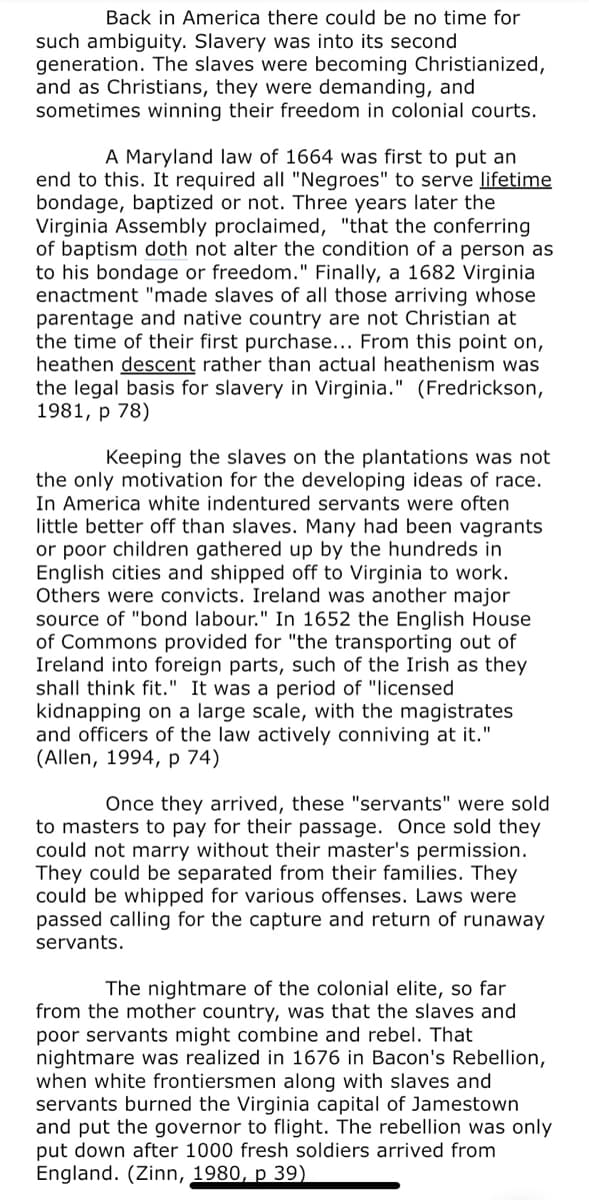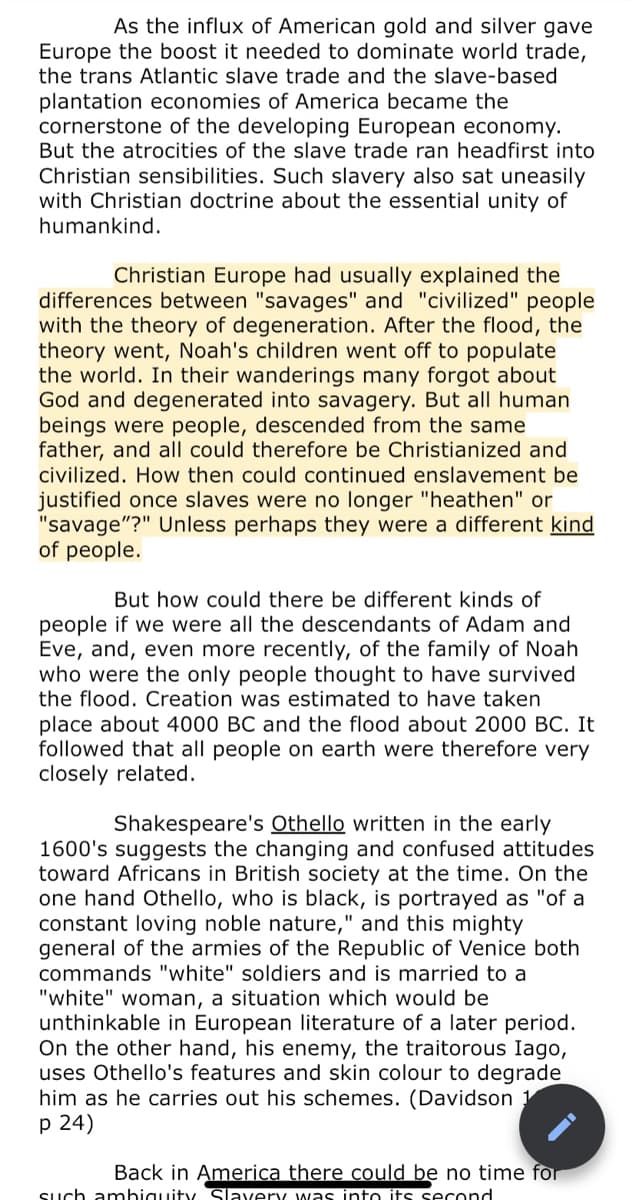When did Native people begin to be considered a special race?
Related questions
Question
When did Native people begin to be considered a special race?

Transcribed Image Text:Back in America there could be no time for
such ambiguity. Slavery was into its second
generation. The slaves were becoming Christianized,
and as Christians, they were demanding, and
sometimes winning their freedom in colonial courts.
A Maryland law of 1664 was first to put an
end to this. It required all "Negroes" to serve lifetime
bondage, baptized or not. Three years later the
Virginia Assembly proclaimed, "that the conferring
of baptism doth not alter the condition of a person as
to his bondage or freedom." Finally, a 1682 Virginia
enactment "made slaves of all those arriving whose
parentage and native country are not Christian at
the time of their first purchase... From this point on,
heathen descent rather than actual heathenism was
the legal basis for slavery in Virginia." (Fredrickson,
1981, р 78)
Keeping the slaves on the plantations was not
the only motivation for the developing ideas of race.
In America white indentured servants were often
little better off than slaves. Many had been vagrants
or poor children gathered up by the hundreds in
English cities and shipped off to Virginia to work.
Others were convicts. Ireland was another major
source of "bond labour." In 1652 the English House
of Commons provided for "the transporting out of
Ireland into foreign parts, such of the Irish as they
shall think fit." It was a period of "licensed
kidnapping on a large scale, with the magistrates
and officers of the law actively conniving at it."
(Allen, 1994, p 74)
Once they arrived, these "servants" were sold
to masters to pay for their passage. Once sold they
could not marry without their master's permission.
ey could be separated from their families. They
could be whipped for various offenses. Laws were
passed calling for the capture and return of runaway
servants.
The nightmare of the colonial elite, so far
from the mother country, was that the slaves and
poor servants might combine and rebel. That
nightmare was realized in 1676 in Bacon's Rebellion,
when white frontiersmen along with slaves and
servants burned the Virginia capital of Jamestown
and put the governor to flight. The rebellion was only
put down after 1000 fresh soldiers arrived from
England. (Zinn, 1980, p 39)

Transcribed Image Text:As the influx of American gold and silver gave
Europe the boost it needed to dominate world trade,
the trans Atlantic slave trade and the slave-based
plantation economies of America became the
cornerstone of the developing European economy.
But the atrocities of the slave trade ran headfirst into
Christian sensibilities. Such slavery also sat uneasily
with Christian doctrine about the essential unity of
humankind.
Christian Europe had usually explained the
differences between "savages" and "civilized" people
with the theory of degeneration. After the flood, the
theory went, Noah's children went off to populate
the world. In their wanderings many forgot about
God and degenerated into savagery. But all human
beings were people, descended from the same
father, and all could therefore be Christianized and
civilized. How then could continued enslavement be
justified once slaves were no longer "heathen" or
"savage"?" Unless perhaps they were a different kind
of people.
But how could there be different kinds of
people if we were all the descendants of Adam and
Eve, and, even more recently, of the family of Noah
who were the only people thought to have survived
the flood. Creation was estimated to have taken
place about 4000 BC and the flood about 2000 BC. It
followed that all people on earth were therefore very
closely related.
Shakespeare's Othello written in the early
1600's suggests the changing and confused attitudes
toward Africans in British society at the time. On the
one hand Othello, who is black, is portrayed as "of a
constant loving noble nature," and this mighty
general of the armies of the Republic of Venice both
commands "white" soldiers and is married to a
"white" woman, a situation which would be
unthinkable in European literature of a later period.
On the other hand, his enemy, the traitorous Iago,
uses Othello's features and skin colour to degrade
him as he carries out his schemes. (Davidson
p 24)
Back in America there could be no time for
Such anmbiguity Slavery was into its second
Expert Solution
This question has been solved!
Explore an expertly crafted, step-by-step solution for a thorough understanding of key concepts.
This is a popular solution!
Trending now
This is a popular solution!
Step by step
Solved in 2 steps
